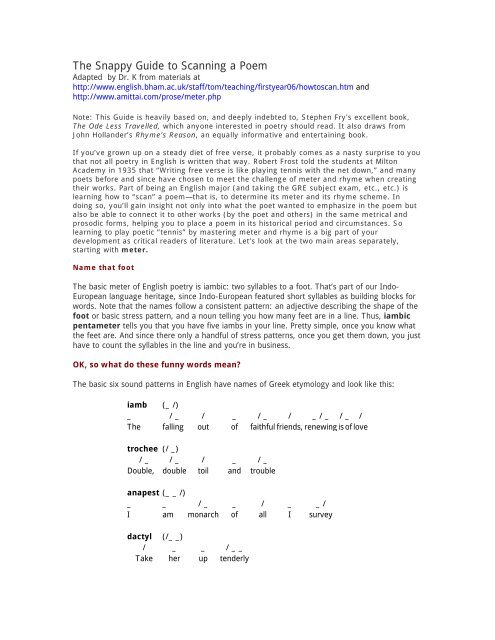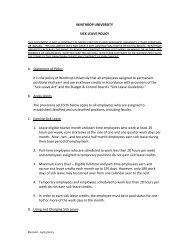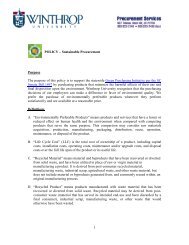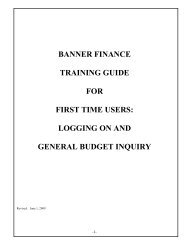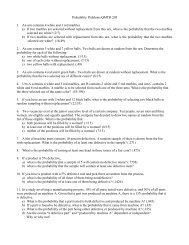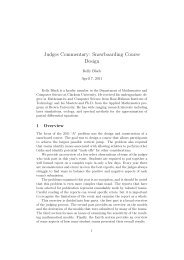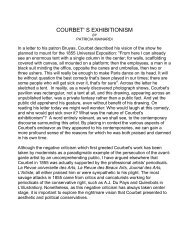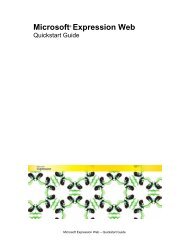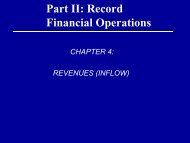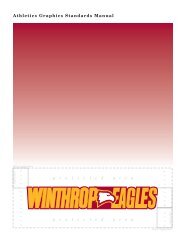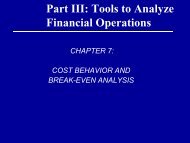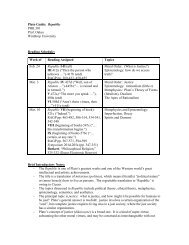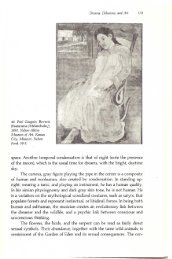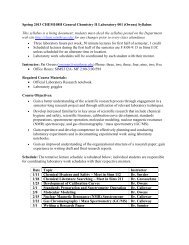The Snappy Guide to Scanning a Poem
The Snappy Guide to Scanning a Poem
The Snappy Guide to Scanning a Poem
You also want an ePaper? Increase the reach of your titles
YUMPU automatically turns print PDFs into web optimized ePapers that Google loves.
<strong>The</strong> <strong>Snappy</strong> <strong>Guide</strong> <strong>to</strong> <strong>Scanning</strong> a <strong>Poem</strong><br />
Adapted by Dr. K from materials at<br />
http://www.english.bham.ac.uk/staff/<strong>to</strong>m/teaching/firstyear06/how<strong>to</strong>scan.htm and<br />
http://www.amittai.com/prose/meter.php<br />
Note: This <strong>Guide</strong> is heavily based on, and deeply indebted <strong>to</strong>, Stephen Fry's excellent book,<br />
<strong>The</strong> Ode Less Travelled, which anyone interested in poetry should read. It also draws from<br />
John Hollander’s Rhyme’s Reason, an equally informative and entertaining book.<br />
If you’ve grown up on a steady diet of free verse, it probably comes as a nasty surprise <strong>to</strong> you<br />
that not all poetry in English is written that way. Robert Frost <strong>to</strong>ld the students at Mil<strong>to</strong>n<br />
Academy in 1935 that “Writing free verse is like playing tennis with the net down,” and many<br />
poets before and since have chosen <strong>to</strong> meet the challenge of meter and rhyme when creating<br />
their works. Part of being an English major (and taking the GRE subject exam, etc., etc.) is<br />
learning how <strong>to</strong> “scan” a poem—that is, <strong>to</strong> determine its meter and its rhyme scheme. In<br />
doing so, you’ll gain insight not only in<strong>to</strong> what the poet wanted <strong>to</strong> emphasize in the poem but<br />
also be able <strong>to</strong> connect it <strong>to</strong> other works (by the poet and others) in the same metrical and<br />
prosodic forms, helping you <strong>to</strong> place a poem in its his<strong>to</strong>rical period and circumstances. So<br />
learning <strong>to</strong> play poetic “tennis” by mastering meter and rhyme is a big part of your<br />
development as critical readers of literature. Let’s look at the two main areas separately,<br />
starting with meter.<br />
Name that foot<br />
<strong>The</strong> basic meter of English poetry is iambic: two syllables <strong>to</strong> a foot. That’s part of our Indo-<br />
European language heritage, since Indo-European featured short syllables as building blocks for<br />
words. Note that the names follow a consistent pattern: an adjective describing the shape of the<br />
foot or basic stress pattern, and a noun telling you how many feet are in a line. Thus, iambic<br />
pentameter tells you that you have five iambs in your line. Pretty simple, once you know what<br />
the feet are. And since there only a handful of stress patterns, once you get them down, you just<br />
have <strong>to</strong> count the syllables in the line and you’re in business.<br />
OK, so what do these funny words mean?<br />
<strong>The</strong> basic six sound patterns in English have names of Greek etymology and look like this:<br />
iamb (_ /)<br />
_ / _ / _ / _ / _ / _ / _ /<br />
<strong>The</strong> falling out of faithful friends, renewing is of love<br />
trochee (/ _)<br />
/ _ / _ / _ / _<br />
Double, double <strong>to</strong>il and trouble<br />
anapest (_ _ /)<br />
_ _ / _ _ / _ _ /<br />
I am monarch of all I survey<br />
dactyl (/_ _)<br />
/ _ _ / _ _<br />
Take her up tenderly
spondee (/ /)<br />
pyrrhic (_ _)<br />
- - / / - - / /<br />
and the white breast of the dim sea<br />
<strong>The</strong> names of the line lengths are easy, <strong>to</strong>o. <strong>The</strong>re’s a prefix that tells you how many feet, and<br />
the root word is always “meter.”<br />
It’s probably going <strong>to</strong> be iambic<br />
monometer one foot pentameter five feet<br />
dimeter two feet hexameter six feet<br />
trimeter three feet heptameter seven feet<br />
tetrameter four feet octameter eight feet<br />
<strong>The</strong> vast majority of poems that you will come across are in meters of iambic pentameter (five<br />
feet, ten syllables) or iambic tetrameter (four feet, eight syllables). Three syllable feet do<br />
occur, but they are rare, and usually used for special effect: comedy, or onoma<strong>to</strong>poeia (where<br />
the sound of the poetry imitates the subject of the poem). More about them below. So, the first<br />
thing <strong>to</strong> do is <strong>to</strong> read the poem <strong>to</strong> yourself, either out loud or in your head. If it is based on three<br />
syllable feet, you'll notice it. If not, then it is almost certainly iambic.<br />
If it is, mark up the line with a pencil, putting in a vertical line after every two syllables.<br />
<strong>The</strong> woods | decay | the woods | decay | and fall<br />
when you | are old | and grey | and full | of sleep<br />
If you can't make it fit <strong>to</strong> a two-syllable pattern, check the expansion/contraction rules (below). If<br />
you still can't, check the trisyllabic feet below. (If you’re working on computer, you can either<br />
capitalize the STRESSED syllables or change the color of the font—whatever works for you.)<br />
When you've sorted out the feet, read the poem again for the sound. Emphasize the stressed<br />
syllables the way you would in normal conversation, not with any “funny” or “literary” effect.<br />
<strong>The</strong> WOODS | deCAY | the WOODS | deCAY | and FALL<br />
when YOU | are OLD | and GREY | and FULL | of SLEEP<br />
How do you know which are stressed and which are unstressed? Stressed words are important<br />
words like nouns and verbs (after that, adjectives and adverbs), unstressed are unimportant<br />
words and sounds (prefixes, suffixes, prepositions, particles). Stressed syllables are those that<br />
you will recognize as stressed because you are a native speaker: no one would say DEcay, for<br />
instance.<br />
Mark the stressed syllables above the words with a diagonal line/ and the unstressed with a<br />
horizontal line —.<br />
You will find that the majority of feet are unstressed syllables preceding stressed ones, like this:<br />
the WOODS. That is an iamb; the meter therefore is iambic.<br />
2
But what if the poet cheats and changes some of the feet?<br />
Poets will do that. If poetry were just a machine that churned out foot after foot of the same<br />
rhythm, there would be a Google <strong>to</strong>ol that did it for you mechanically. What changes mechanical,<br />
sing-song verse in<strong>to</strong> poetry is how the poet uses occasional variation in the meter <strong>to</strong> subtly<br />
emphasize the meaning of the poem. This is what makes the poem interesting and not just a<br />
sing-song chant (though a good poet can get wonderful effects from a sing-song chant).<br />
<strong>The</strong>re are three possible kinds of substitution. Instead of unstressed/stressed (iambic), you can<br />
have<br />
1. stressed/unstressed. This is a trochee, and is therefore trochaic substitution.<br />
2. stressed/stressed. This is a spondee, and is therefore spondaic substitution.<br />
3. unstressed/unstressed. This is a pyrrhus, and therefore pyrrhic substitution.<br />
Here are some examples, <strong>to</strong> show how the substitutions (in a good poet) enhance the meaning:<br />
Trochaic substitution<br />
Far from the madding crowd's ignoble strife<br />
FAR from | the MAD | ding CROWD'S | ignOB | le STRIFE<br />
Trochaic substitution in the first foot <strong>to</strong> emphasize distance<br />
My heart aches, and a drowsy numbness pains<br />
My HEART | ACHES and | a DROW | sy NUMB | ness PAINS<br />
Trochaic substitution in the second foot <strong>to</strong> emphasise the ache: the pain<br />
Spondaic substitution<br />
On BOTH | SIDES THUS | is SIM | ple TRUTH | supPRESS'D<br />
Spondaic substitution in the second foot <strong>to</strong> show how the world contradicts itself (the<br />
whole of Shakespeare’s Sonnet 138 is intricately patterned around the theme of lies and<br />
contradictions).<br />
Pyrrhic substitution<br />
Shall I compare thee <strong>to</strong> a summer's day?<br />
SHALL i | comPARE | thee <strong>to</strong> | a SUM| mer's DAY?<br />
Trochaic substitution in the first foot <strong>to</strong> emphasise wondering. But also pyrrhic<br />
substitution in the third foot, like a pause as he thinks of something amazing <strong>to</strong> compare<br />
her with. And finds it. You could read the first foot as a iamb, but the trochaic stress<br />
seems better (<strong>to</strong> me, at any rate). This is not rocket science: you get choices.<br />
Not in the hands of boys, but in their eyes<br />
Shall shine the holy glimmers of goodbyes<br />
NOT in | the HANDS | of BOYS, | but in | their EYES<br />
This is Wilfred Owen, on the horror of the First World War, where young men—boys—<br />
were slaughtered in hundreds of thousands. Trochaic substitution in the first foot <strong>to</strong><br />
emphasise NOT; pyrrhic substitution in the fourth foot, <strong>to</strong> give a build-up <strong>to</strong> the image of<br />
the eyes of all these dead young men.<br />
Shall SHINE | the HOL | y GLIM | mers of | goodBYES<br />
Repetition of the pyrrhic substitution in the fourth foot, <strong>to</strong> give a pattern: the goodbyes<br />
are in their EYES. Also, <strong>to</strong> give a pause—wait for it—before the tragic final two syllables<br />
of the line. You can find the whole of this fantastic poem here.<br />
3
So, when you analyze a poem, what you need <strong>to</strong> do is <strong>to</strong> find all the substitutions and comment<br />
on them. In a good poet, there will be a reason for every one, and the reason will be <strong>to</strong> do with<br />
the meaning of the poem.<br />
Line endings<br />
Next, look at the line endings. How do they affect the meaning? <strong>The</strong> lines will either be ends<strong>to</strong>pped<br />
(the line ends with a natural break in the sense, often emphasized by punctuation):<br />
Shall I compare thee <strong>to</strong> a summer's day?<br />
Thou art more lovely and more temperate.<br />
Or else the line will run on:<br />
And sometime like a gleaner thou dost keep<br />
Steady thy laden head across a brook<br />
This is called enjambment and is often used for poetic effect, as here; the line end, plus the<br />
trochaic substitution in the first foot of the second line, give you the balancing act that she must<br />
do as she crosses the brook.<br />
John Donne was a master of enjambment:<br />
On a huge hill,<br />
Cragged and steep, Truth stands, and he that will<br />
Reach her, about must and about must go,<br />
And what the hill's suddenness resists, win so.<br />
(Note the emphasis on -ed in | CRAGged |).<br />
<strong>The</strong> poem imitates the action and effort (will/REACH) of climbing the hill in search for truth. In<br />
the last line, the trochaic substitution in the third foot, plus the elision or running-<strong>to</strong>gether of<br />
the middle syllable of that foot (SUDd'nness), plus the awkward s sounds give the effort and<br />
difficulty of the climb; the spondaic substitution in the last foot gives a sense of release and<br />
success. Brilliant.<br />
And WHAT | the HILL'S | SUDd'nness | reSISTS | WIN SO<br />
Despite what your first-grade teacher taught you about s<strong>to</strong>pping and taking a breath at the end<br />
of each line of poetry so that all the other first graders could hear the rhymes, when a line is<br />
enjambed, you should read it that way, so that your audience hears the energy and motion of<br />
that wraparound syntax. You can give a slight pause at the line’s end, but don’t read enjambed<br />
lines in that sing-song “Mary Had A Little Lamb” way if you’re a grownup student of literature.<br />
Save it for “reading <strong>to</strong> the class” day at your child’s elementary school.<br />
<strong>The</strong> Caesura<br />
Most lines of poetry have a natural pause, usually in the middle. This is the caesura.<br />
Not in the hands of boys, || but in their eyes<br />
This can be used <strong>to</strong> reinforce the meaning:<br />
And what the hill's suddenness resists || win so.<br />
4
That's a delayed caesura before the last foot, reinforcing the feeling of triumph and attainment<br />
in—wait for it—WIN SO.<br />
So, in each line of a poem, look for the caesura, and see what sort of work it's doing.<br />
<strong>The</strong> eleven-syllable iambic pentameter line<br />
Poets aren’t necessarily good at math, but sometimes they miscount for a reason. Occasionally<br />
you’ll find a line that feels like iambic pentameter but has eleven syllables. called a<br />
hendecasyllable. It's because though most English words end with a stressed syllable, many<br />
don't, and poets didn't want <strong>to</strong> deny themselves the possibility of ending a line with one of them,<br />
such as '<strong>to</strong>morrow' or 'question'. Do these sound familiar?<br />
To BE | or NOT | <strong>to</strong> BE || THAT is | the QUES | tion<br />
11 syllables, with a trochaic reversal after the caesura: Hamlet is very puzzled, and fears death.<br />
ToMORR | ow and | ToMORR | ow and | ToMORR | ow<br />
Hendecasyllablic with no less than two pyrrhic substitutions. Because so many syllables are<br />
unstressed, the stressed syllable sounds like the crack of doom: bang—wait for it—Bang—wait<br />
for it—BANG.<br />
Two of the greatest lines in the whole of English. For that, you can learn <strong>to</strong> live with a long<br />
mysterious sounding Greek word: hendecasyllabic. <strong>The</strong> same goes for a line famous in<br />
American pop culture:<br />
To BOLD | ly GO | where | no MAN | has GONE | BE fore<br />
<strong>The</strong> hendecasyllabic intrusion in the middle of the line makes you wait for the result of that bold<br />
going—and then that trochaic (or some would say spondaic) ending just punches the meaning<br />
home. That’s why the line is so memorable—the rhythms just engrave it on your ears.<br />
Expansion/contraction rules<br />
a. Words ending in -er or -en (e.g., ever, never, or heaven, given) are often treated as one<br />
syllable: "heav'n." In older texts they are sometimes spelled that way, <strong>to</strong>o.<br />
b. When a word ends with -ed the ed can be pronounced as a separate syllable: naked; or<br />
not: passed. Sometimes it's optional: winged can be said with two syllables, or one<br />
(wing'd). Poets exploit that possibility <strong>to</strong> add or lose a syllable. Watch out for it.<br />
c. When two vowels are next <strong>to</strong> each other, they can often be scanned either as two<br />
syllables or one (offbeat) syllable, depending on what the poet needs for the meter. In<br />
words that have a u before another vowel, it may be treated like a w: unusual, "un-Uzhwal"<br />
(3 syllables) or "un-U-zhu-AL" (4 syllables). I may be treated as a y: proverbial:<br />
"pro-VERB-yal" or "pro-VERB-i-AL." You can detect this by simply relying on your instinct<br />
as a native speaker of English.<br />
d. When you have an unaccented vowel ending one word and another one beginning the<br />
next word you can elide (it means slur, or run) them <strong>to</strong>gether. This is called elision.<br />
is spoken as<br />
<strong>The</strong> expense of spirit in a waste of shame<br />
5
Th'expense of spirit in a waste of shame<br />
e. <strong>The</strong> endings -tion and -sion may be scanned as one syllable (as <strong>to</strong>day) or as two, with<br />
secondary stress on the -on.<br />
Our two souls therefore, which are one,<br />
Though I must go, endure not yet<br />
A breach, but an expansion,<br />
Like gold <strong>to</strong> aery thinness beat.<br />
A BREACH || but an | exPAN | si-on<br />
After the caesura, the two pyrrhic substitutions surround the iambic foot so that the<br />
emphasis exPANDS <strong>to</strong> compensate.<br />
Don't be intimidated by this. It's not difficult, and mostly you can get it by instinct. Practice out<br />
loud while you’re working with that pencil—the worst that can happen is that people around you<br />
will hear some good poetry instead of the blather of people chatting on their cell phones.<br />
But what if it's not iambic?<br />
Well, it's either going <strong>to</strong> be trochaic, or dactyllic, or anapaestic. But these strange meters will<br />
always signal themselves clearly, and either be used for comic effect, or for sound effect. You<br />
can hardly not notice them, or mistake them. And they really are rare.<br />
Trochaic (STRESSED unstressed)<br />
You could trace them through the valley,<br />
By the rushing in the Spring-time,<br />
By the alders in the Summer,<br />
By the white fog in the Autumn,<br />
By the black line in the Winter;<br />
YOU could | TRACE them | THROUGH the | VALLey,<br />
BY the | RUSHing | IN the | SPRING-time<br />
and so on, and on. This is Longfellow's Hiawatha. It's very mono<strong>to</strong>nous. Very hard <strong>to</strong> think of<br />
another example of pure trochaic, with good reason: the English language doesn't like it.<br />
three styllable (trimeter): Dactyllic<br />
STRESSED unstressed unstressed.<br />
Cannon <strong>to</strong> right of them<br />
Cannon <strong>to</strong> left of them<br />
Cannon in front of them<br />
Volleyed and thundered.<br />
CANNon <strong>to</strong> | RIGHT of them<br />
CANNon <strong>to</strong> | LEFT of them<br />
CANNon in | FRONT of them<br />
VOLLeyed and | THUNdered.<br />
6
It's about a cavalry charge. Horses galloping. <strong>The</strong> verse gallops <strong>to</strong>o.<br />
three styllable (trimeter): Anapaestic<br />
Unstressed unstressed STRESSED<br />
I sprang <strong>to</strong> the stirrup, and Joris, and he;<br />
I galloped, Dirck galloped, we galloped all three;<br />
I SPRANG | <strong>to</strong> the STIRR | up, and JOR | is, and HE;<br />
I GALL | oped, Dirck GALL | oped, we GALL | oped all THREE;<br />
More galloping. <strong>The</strong> problem is, you can't do <strong>to</strong>o much of this, or it gets really tedious. That's<br />
why the poet has placed an iambic substitution in the first foot. Apart from that, it's all galloping.<br />
You don't really have <strong>to</strong> worry about these. When they occur, they are obvious, and easy <strong>to</strong> scan.<br />
And they very rarely happen. More worrying is<br />
Mixed meter<br />
Towards the end of the nineteenth century, and in<strong>to</strong> the beginning of the twentieth, poets began<br />
<strong>to</strong> feel that the rule book was pretty much of a hindrance; that all the good stuff had been done<br />
in the usual forms. So, they started getting creative with the rule book. When this happens in a<br />
poem, it's obvious when you read it that something is going on, because the meter is so strange;<br />
but scanning it is difficult. However, don't worry: it is so difficult that no-one will mind if you get<br />
bits of it wrong. We won’t even go in<strong>to</strong> Gerard Manly Hopkins’ sprung rhythm here; if you must<br />
know, buy Dr. Naufftus or Dr. Brownson a cup of coffee and ask them <strong>to</strong> explain it <strong>to</strong> you.<br />
What about rhyme schemes?<br />
Rhyme is the repetition of similar sounds in comparable syllables of different words. In standard<br />
rhyme in English, the initial consonant (or initial consonant group) of rhyming syllables is not<br />
repeated, but the rest of the syllable is repeated — the vowel, and any closing consonant or<br />
consonants, if present. Standard rhyming matches the vowel of the last stressed syllable of<br />
rhyming words, and any sounds following the vowel, including any unstressed syllables coming<br />
after that last stressed syllable. Thus folk rhymes with poke; allow rhymes with plow; hollow<br />
rhymes with follow; and writing rhymes with exciting. Exciting does not rhyme with thing,<br />
however, since the -ing in exciting is not stressed. Any rhyme with exciting must repeat the<br />
entire sound following the initial consonant of the last stressed syllable, here soft c, and thus<br />
must end in -iting. Rhymes consisting of stressed final syllables alone are called masculine<br />
rhymes, such as approach/coach; rhymes including an unstressed syllable after the stressed one<br />
are called feminine: Apollo/swallow.<br />
Rhyme is determined by sound, not spelling, so don’t get fooled. Which of these two pair of<br />
words rhyme?<br />
puff / enough<br />
through / though<br />
Standard rhymes are perfect rhymes, in which the vowel of the last stressed syllable and all<br />
following sounds are repeated exactly. Some poetry uses near rhymes, also called slant<br />
rhymes or imperfect rhymes. <strong>The</strong>se may make use of assonance, which is the repetition of<br />
the vowel but with different consonants following it, or consonance, which is the repetition of<br />
7
the consonant or consonants following the vowel but the use of different vowels, or a<br />
combination of the two, using either vowels or consonants that are similar but not the same.<br />
Rhyme variation often happens in hip-hop lyrics, often with comic effect, as in Eminem’s Lose<br />
Yourself:<br />
Yo, His palms are sweaty, knees weak, arms are heavy<br />
<strong>The</strong>re's vomit on his sweater already, mom's spaghetti<br />
He's nervous, but on the surface he looks calm and ready<br />
To drop bombs, but he keeps on forgetting<br />
What he wrote down, the whole crowd grows so loud<br />
He opens his mouth, but the words won't come out<br />
<strong>The</strong> vowel sounds in sweaty, heavy, sweater, already, spaghetti and ready all assonate, so they<br />
are near rhymes, as are down, crowd, loud, mouth, and out. Part of Eminem’s skill in this<br />
composition is the way he strings both internal and final rhymes <strong>to</strong>gether <strong>to</strong> unify the lines.<br />
Different periods and dialects of English may make certain rhymes possible that do not seem<br />
evident in contemporary Modern Standard English. All of these rhymes reflect pronunciations in<br />
which the sounds actually do rhyme, or form near rhymes. A few examples in Early Modern<br />
English poetry, including Shakespeare, are:<br />
• Words ending in -y (or -ly, etc.) rhyme with words like die and eye: memory/die;<br />
symmetry/eye.<br />
• Words ending in unaccented -a rhyme with words like day: Julia/day.<br />
• Words having the oi diphthong rhyme with words with a long i: boil/style.<br />
• Do and go often rhyme, perhaps as a close o sound intermediate between "oh" and<br />
"oo," something like the sound of the o in Minnesota as pronounced by some<br />
Minnesotans.<br />
• Likewise, done sometimes rhymes with gone. Somewhat similarly, love often rhymes with<br />
move and prove — perhaps the vowel in all of them was about the same as now the<br />
vowel in foot — a pronunciation still current for these words in some areas of Northern<br />
England and Scotland.<br />
• In Scottish texts such as ballads, words ending in -ie may rhyme with words ending in -<br />
ee: die/see.<br />
Likewise, other words may be syllabified differently in Early Modern English, in ways that affect<br />
rhyme. In Shakespeare's Sonnet 18, temperate takes three syllables ("TEM-puh-rate," rather<br />
than "TEMP-ruht") and rhymes with date. In Anne Bradstreet's poetry, safety takes three<br />
syllables ("SAFE-uh-tee" or "SAFE-uh-tie") and rhymes in ways that apply <strong>to</strong> other -y endings.<br />
Difference is sometimes pronounced as three syllables and rhymes with words like fence hence,<br />
as it does in a modern poem, Robert Frost's "<strong>The</strong> Road Not Taken."<br />
So why does rhyme matter? Because when poets put patterns of rhyme <strong>to</strong>gether, they give<br />
shape and emphasis <strong>to</strong> the meaning of the poem. <strong>The</strong>se patterns of rhyme are called rhyme<br />
schemes. We usually describe them by using letters <strong>to</strong> indicate which lines rhyme. For example<br />
abab indicates a four-line stanza in which the first and third lines rhyme, as do the second and<br />
fourth. Here is an example of this rhyme scheme from To Anthea, Who May Command Him Any<br />
Thing by Robert Herrick:<br />
Bid me <strong>to</strong> weep, and I will weep,<br />
While I have eyes <strong>to</strong> see;<br />
And having none, yet I will keep<br />
8
A heart <strong>to</strong> weep for thee.<br />
Sounds in orange are marked with the letter A<br />
Sounds in purple are marked with the letter B<br />
So the rhyme scheme of this stanza is ABAB.<br />
Some rhyme schemes are so consistent that literary critics have given special names <strong>to</strong> them;<br />
this is particularly true of sonnets. An Italian or Petrarchan sonnet will rhyme lines of iambic<br />
pentameter using five sounds in the pattern abba abba with a sestet of cde cde in some<br />
variation (there are lots of possibilities). An English or Shakespearean sonnet will rhyme<br />
iambic pentameter lines using seven sounds in the pattern abab cdcd efef gg. A Spenserian<br />
(or masochistic) sonnet will rhyme iambic pentameter lines using five sounds in the pattern abab<br />
bcbc cdcd ee. Tennyson’s In Memoriam stanza was rhymed lines of iambic tetrameter in the<br />
pattern abba. Learn the basics, and before you know it you’ll be <strong>to</strong>ssing off clerihews, ottava<br />
rima, rondelets, and sestinas with lavish abandon.<br />
If you want some practice, try the examples on this web page:<br />
http://www.curriki.org/xwiki/bin/view/Coll_rmlucas/Poetry-<br />
RhymeSchemePractice.<br />
When determining a rhyme scheme, remember that the pronunciation of words has changed<br />
greatly over the years. Give some thought <strong>to</strong> how a word might have sounded before you decide<br />
"That doesn't rhyme" and throw the book down in disgust! Word meanings have changed, <strong>to</strong>o,<br />
and the Oxford English Dictionary is the best place <strong>to</strong> look up words and figure out what they<br />
meant at the time a particular author was writing. And if you’re working with Emily Dickinson,<br />
who was inspired by the many hymn meters of her time, remember that she counts syllables and<br />
not feet—but that’s matter for a different <strong>Snappy</strong> <strong>Guide</strong>.<br />
9


